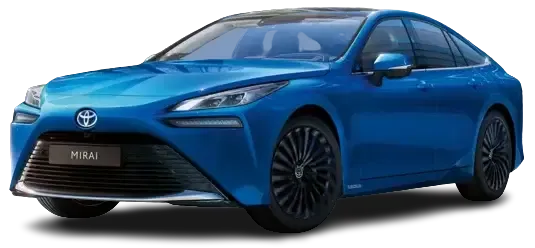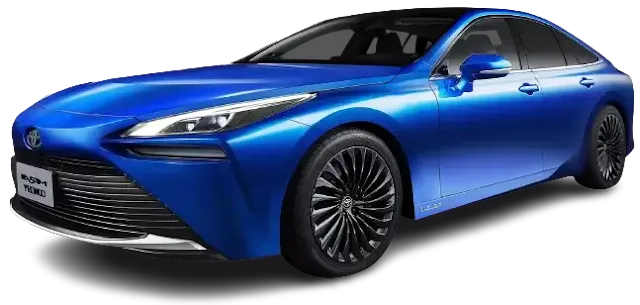Toyota Mirai: HYDROGEN AND THE FUEL CELL. 0% EMISSIONS
TOYOTA MIRAI HIGHLIGHTS
 |
| Toyota Mirai |
An attractive design
The Toyota Mirai is based on the latest generation TNGA-L platform. The slender lines and the silhouette of a 4-door coupé sedan contribute to its resolutely athletic character. Its elegant proportions and sculptural 19” and 20” wheels give the Toyota Mirai a remarkable presence on the road.
A new driving experience
The 182 horsepower electric motor delivers up to 300nm of torque for exhilarating performance. On board, the refined atmosphere goes perfectly with the remarkable soundproofing of the passenger compartment. The agility of the chassis and the comfort of the suspensions guarantee passengers well-being and peace of mind.
Embedded technology
Digital rear-view mirror, 360° vision system, blind spot detector (BSM) and 12.3'' head-up display will make driving easier in any situation. The 12.3'' multimedia system, as intuitive to use as a tablet, provides easy access to all on-board functions.
Starting at VAT: $71,500
CO2 emissions (WLTP): 0g/km
Choose your version and engine: 2 options
Mirai Executive Hybrid Sedan Coupe 4-Door
HYDROGEN AND THE FUEL CELL
To turn hydrogen into electricity, we need a fuel cell. Toyota's new fuel cell system creates energy through the reaction of hydrogen and oxygen. It's a process that happens in an instant, which powers the electric motor and releases only water.
The more you drive with Mirai, the more you purify the air
Thanks to its air purification system, Toyota Mirai neutralizes and eliminates up to 95% of the pollutants contained in the air. The amount of air purified by the Toyota Mirai over 10,000 kilometers is equivalent to the amount of air breathed by a person over a full year.
An advanced parking system
Sit back and enjoy Toyota's first autonomous parking assistant in Europe. This system manages the steering, braking, acceleration, forward/reverse gear change autonomously.
Parallel park, parallel or parallel park, and automatically exit a parallel space, all with the touch of a button. Let Mirai maneuver for you with three pre-programmable parking spaces to seamlessly park at home or at work.
STAY AHEAD
With the new Mirai, intuitive technology makes every journey safer.
Automatic high beam management
A camera, located at the top of the windscreen, detects the headlights of oncoming vehicles while measuring the ambient light. The system automatically switches from high beam to low beam depending on the conditions, allowing you to concentrate fully on the road, without compromising your safety or dazzling other motorists.
Intelligent adaptive cruise control going to a stop
This technology includes the features of adaptive cruise control combined with road sign reading, which automatically keeps the car at a pre-selected speed and warns the driver if the speed limit changes. When the vehicle approaches a curve, its speed decreases in the curve in order to maintain perfect stability of the vehicle.
Lane Departure Alert with Lane Keeping Aid
Lane Departure Alert helps you stay on your path by triggering an audible and visual alarm, as well as light steering wheel input if your vehicle begins to drift out of its lane and cross lane markings without the turn signal. has been triggered.
Trajectory assistant
Lane departure warning uses either the lane markings in front of the vehicle or the trajectory of the vehicle in front to estimate its position on the road.
Pre-collision safety system with detection of vehicles, pedestrians (day and night) and cyclists, also active at intersections.
This system can detect vehicles, pedestrians (day and night) and cyclists (day). When the risk of collision is detected, the driver is alerted by audible and visual warnings. If he does not react, the brakes are applied automatically.
Reading road signs with speed limiter
The system monitors traffic signs in front of you, displaying the applicable speed limit or overtaking restrictions, on the color TFT display.
Toyota Mirai
The first mass-produced hydrogen car in the world, the Toyota Mirai began its career in a few countries including France in 2018 and is renewed in 2021 in a second generation completely redesigned and increasing its range to 650 kilometers.
Design of the Toyota Mirai
On the design side, Toyota has clearly played the card of rupture with the Mirai. It stood out from other models of the brand with an innovative style evoking the "mobility of the future". Objective: to seduce “early adopters“, the first customers of the hydrogen sedan. With a "teardrop" profile, the Mirai sports impressive side air intakes framed by chrome bars intended to reinforce its grille. At the rear, the shapes are just as special and allow the Mirai to adopt a look of its own, of which only a few tiny details are shared with the Toyota Prius 4.
In 2020, everything changes thanks to the adoption of the Lexus LS platform. 8.5 cm taller, 6 cm wide and 6 cm low, the Mirai transforms into an attractive sedan. In addition to her imposing physique of 4.97 m, she ignores exaggerated folds for sleek shapes. It is thus closer to its cousin, but takes on a very original interior in the Toyota spirit.
In terms of habitability, the first Toyota Mirai suffered from its many components and only offered 4 seats and a small 391-litre trunk. The Mirai cru 2020 has therefore reviewed its copy. It has an increased wheelbase, a fuel cell migrating to the front and a reduction in battery size. The space on board and the trunk are therefore larger.
How the hydrogen car works
The TFCS system (Toyota Fuel Cell System) of the Toyota Mirai uses two sources of energy:
A fuel cell (PAC) used to transform hydrogen into electricity
A battery recovering energy during braking and deceleration provides more power during acceleration
These two elements power an electric motor. On the Mirai I, it is located at the front, powerful with 113 kW (154 hp) and 335 Nm and driving the front wheels. No longer traction but propulsion, the Mirai 2020 places its 134 kW (182 hp) and 300 Nm engine at the rear.
The heat pump, initially 114 kW (155 hp) in 2014, is evolving to 128 kW (174 hp) in 2020. It also moves from the floor to the front bonnet to free up space on board. The original 1.6 kWh Ni-Mh battery was taken from the Camry Hybrid. The second generation not only reduces its size with lithium-ion chemistry, but increases its voltage to 311 V (vs 230). Its capacity is however reduced to 1.2 kWh with an amperage of 4 Ah. The Toyota Mirai reaches a maximum speed of 178 km/h and sprints from 0 to 100 km/h in 9.6 seconds. Heavier by 100 kg but more powerful, the second generation should be of the same ilk.
In use, the Toyota offers three driving modes: Normal, Eco and Power. An additional “Brake” mode accentuates engine braking and energy recovery.
Range and refueling of the Toyota Mirai
Two T-shaped tanks occupy the floor containing 4.6 kg of gas at a pressure of 700 bars. The Toyota Mirai thus has ultra-secure and carbon fiber reinforced tanks. The 2020 version adopts a third tank under the trunk, increasing the volume to 142 liters of hydrogen (H2). This gives a weight of 5.6 kg of H2, increasing the range from 500 to 650 kilometers in the WLTP cycle.
While the Prius can use any gas station to refuel, the Toyota Mirai has to rely on a specific hydrogen refueling infrastructure network. Refueling, however, is no more complicated than a classic full tank and takes a few minutes. Once connected to the car by means of a nozzle, the station automatically assesses the pressure differential to trigger, or not, the hydrogen refueling of the car.
Note that the Mirai needs hydrogen stations operating at 700 bars to fully fill up. The price per kg of H2, now zero-rated, is around $10, or $50 to $60 per tank.
Price and marketing of the Toyota Mirai
The Mirai began its career in 2014 in Japan and California, then in October 2015 in Europe. The sedan was offered only in countries with sufficient hydrogen refueling infrastructure. Thus, its marketing was initially limited to 4 countries of the old continent: Germany, Denmark, Belgium and the United Kingdom. In France, marketing only started in October 2018 thanks to the appearance of a few hydrogen refill stations.
The first generation of Toyota Mirai was sold from 78,900 $. However, the manufacturer preferred to direct its customers to LLD. Like the electric cars marketed in France, the Toyota Mirai is eligible for the ecological bonus, since it does not emit CO2.











